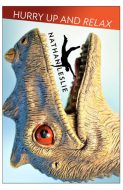 Nathan Leslie
Nathan Leslie
Hurry Up and Relax
Washington Writers Publishing House
Reviewer: Charles Rammelkamp
Hugh, the protagonist narrator of “Huggers Not Muggers,” one of the almost two dozen stories in Nathan Leslie’s darkly humorous prizewinning new collection, observes of Lyn, one of his co-workers at Huge, the mega-store where they work, that she’s “like some kind of born-again Christian doll version of herself.” This is the profile of so many of Leslie’s characters in these stories, people who are trying hard to understand who they are and how they fit in. Hugh, who himself belongs to this category, likewise observes of another colleague at Huge, “I hate it when Sven gets faux-folksy—he is nothing close to folksy and never will be and his facade comes across as contrived and sarcastic, though he means for it to sound earnest.” We’ve all known people like that, haven’t we? We might even be guilty ourselves, trying to sound like “plain folks,” “regular guys.” Aw shucks.
Reflecting the modern workplace of cubicle-dwelling misfits, so many of these stories are about people trying to conform in a meaningful way. In “The Enforcer,” Ned Leavan is laid off from his job and decides to be a traffic-calmer for his neighborhood. “Perhaps, I thought, enforcing the law is just another way of finding meaning in meaninglessness.” It ends horribly, of course. Ned’s wife leaves him, he’s thinking of applying for a job as a dishwasher in a fast food restaurant. (And what a terrific sentence to describe the moment when Ned realizes it’s the end of the marriage: “This was the beginning of the end, though: I could tell. She had a thread and I was the sweater.”)
The protagonist of a Leslie story is usually a sadsack, a clueless guy down on his luck. There are plenty of Yiddish words to describe him: Shlumpf, shnook, shmoe, shmendrik, shlimazel, shlemiel, nebbish, not that these characters are Jewish, but you get the picture. Take the protagonist of the title story, a nervous guy on a staycation from work, Paulie, who takes on an inept handyman with the unlikely name of Lans Fill. It does not end well, and Paulie certainly doesn’t get the rest and relaxation he’d aimed for.
To sum up the Leslie protagonist, take this droll passage from the story, “I Am Not a Hamster!” told by a man toiling away on various pieces of exercise equipment at a health club (yeah, like a hamster running in its wheel!).
Diamond Gym likes the exclamation mark! I have come to embrace it myself! With the exclamation mark life seems so much more exciting! It makes me feel less down-spirited and sour about my current state of employment (which is no employment)! And lack of a love life!
The black humor overflows, but along with the laughter we feel pity; only, it’s the kind of pity you feel for a nebbish.
The Leslie protagonists’ relationships with the opposite sex are likewise catastrophic. They all suffer from low self-esteem. There are moments of painful self-recognition that drive home the point. In “Peanut Brittle,” the protagonist, Wil, reflects at the end:
Peanut Brittle – that describes him perfectly, he realizes. All his life he was destined to become Peanut Brittle. A brittle little turd of a legume. And even more so since he doesn’t eat peanuts. He’s allergic to himself. He’s a stupid, needless sweet. An afterthought.
All of this follows strange social-media interactions (or lack thereof) involving a woman named Margie and Wil’s wife Kelley.
The female protagonist of “It Can’t Hurt, Can It?”, a New Age therapist straight out of a T.C. Boyle story, is likewise dealing with a failed relationship – “the air slowly hissed out of the balloon of our marriage” – second-guessing and revising along the way. She practices reiki on her patients, a form of alternative medicine called energy healing, in which the therapist channels energy into the patient to activate the natural physical and emotional healing processes of the body. Charlotte Felicity Emily Grainsborough (CFEG) double-thinks her way to a successful marriage. For although it failed in less than a year, “this is only in Earth time. In the inner landscape where we all actually reside, our love lasted for eons.”
The commentary on the larger culture in which these oddballs live their lives provides a familiar context. Take “Courting the Un-Bob,” a comic take of male friendships, the casual betrayals, all captured in the image of “Bob” – Beer Bob, Craigslist Bob, Card Shark Bob, Barefoot Bob – and Gary! Or consider the story “E-Licks-Sir,” about a couple of twenty-first century dudes, the rise and fall of their energy drink start-up business, the brief elation, the inevitable disappointment. These stories shine a light on the mystery of the “Millennial,” who turns out to be as familiar in his/her unlikely human drama as any baby boomer or Gen-Xer ever was.
But there’s so much more to be said about Leslie’s fiction. Take the brilliantly constructed story “Head to Toe,” another take on an alienated protagonist with a lousy sex life and her dysfunctional family. The narrative is ingeniously structured around body parts, from scalp to toenails, with the poignant observation toward the end, “What happened to flesh and blood?” Other stories feature equally inventive narratives, including “The Other Person,” which is both wry commentary on and an original twisting of the second-person narrative.
The collection is neatly contained between two “lists”: “A How To Guide” to the stories that follow (“For sage advice on how to:” followed by a list of bullet points) and “The Exit Poll,” a “user survey” of sorts of the stories just read, a checklist with about a dozen prompts such as “Hurry Up and Relax made me a better person.” It’s a nice postmodern touch that every short story collection should have! Hurry Up and Relax is both an entertaining read and an instructive manual (see “How To …”) in the art of storytelling.

